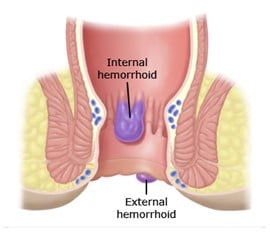Hemorrhoids do not always cause symptoms. But when they do, symptoms can include:
- Itching of the skin around the anus
- Bleeding – Bleeding is usually painless. You might see bright red blood after using the toilet.
- Pain – If a blood clot forms inside a hemorrhoid, this can cause pain. It can also cause a lump that you might be able to feel.
- Swelling – Hemorrhoids can swell or dangle outside of the rectum during a bowel movement.
You should see a doctor or nurse if you have any symptoms, especially bleeding or if your bowel movements look like tar. Bleeding could be caused by something other than hemorrhoids, so you should have it checked out.
If you do have hemorrhoids, your doctor or nurse can suggest treatments. But there some steps you can try on your own first.
The most important thing you can do is to keep from getting constipated. You should have a bowel movement at least a few times a week. When you have a bowel movement, you also should not have to push too much. Plus, your bowel movements should not be too hard, and you should not spend too much time on the toilet (for example, reading).
Being constipated and having hard bowel movements can make hemorrhoids worse. Here are some steps you can take to avoid getting constipated or having hard stools:
- Eat lots of fruits, vegetables, and other foods with fiber. Fiber helps to increase bowel movements.
You need 20 to 35 grams of fiber a day to keep your bowel movements regular. If you do not get enough fiber from your diet, you can take fiber supplements. These come in the form of powders, wafers, or pills. They include psyllium seed (sample brand names: Metamucil, Konsyl), methylcellulose (sample brand name: Citrucel), polycarbophil (sample brand name: FiberCon), and wheat dextrin (sample brand name: Benefiber). If you take a fiber supplement, be sure to read the label so you know how much to take. If you’re not sure, ask your doctor nurse.
- Take medicines called “stool softeners” such as docusatesodium (sample brand names: Colace, Dulcolax). These medicines increase the number of bowel movements you have. They are safe to take and they can prevent problems later.
Some people feel better if they soak their buttocks in 2 or 3 inches of warm water. You can do this up to 2 to 3 times a day for 10 to 15 minutes. Do not add soap, bubble bath, or anything to the water.
There are also medicines that you can get without a prescription. They are usually creams or ointments that you rub on your anus to relieve pain, itching, and swelling. Some hemorrhoid medicines come in a capsule (called a suppository) that you put inside your rectum. Others come in a cream that comes in a bottle with a nozzle that you put inside your rectum. It is OK to try these medicines. But do not use medicines that have hydrocortisone (a steroid medicine) for more than a week, unless your doctor or nurse approves.
If you still have symptoms after trying the steps listed above, you might need treatments to destroy or remove the hemorrhoids.
One popular treatment for hemorrhoids inside the rectum is called “rubber band ligation.” For this treatment, the doctor ties tiny rubber bands around the hemorrhoids. A few days later the hemorrhoids shrink and stop bleeding. Doctors can also use lasers, heat, or chemicals to destroy hemorrhoids. But if none of these options works, your doctor might suggest surgery to remove or tie off the blood vessels of the hemorrhoids. Hemorrhoids on the outside of the rectum can only be removed with surgery.




